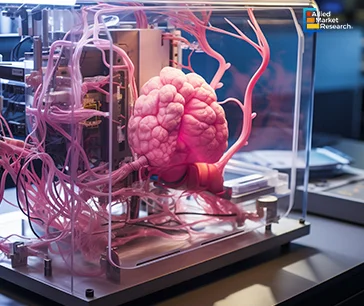Table Of Contents
- Technological Shift in Healthcare – Integration of Generative AI
- The Rise of Telemedicine and Digital Health – Enabling Healthcare Services Reach Every Corner
- Rapid Adoption of Personalized Medicines – Offering Tailored Treatment solutions
- Biosimilars – Promoting Affordability and Quality Care
- Tissue Engineering – Leading a Path for the Future of Healthcare
- Summarizing the Rising Growth of the Life Science Domain

Roshan Deshmukh

Koyel Ghosh
Top 5 Life Science Trends for Q2 2024: Innovations Reshaping the Future of Healthcare

The life science sector includes various industries dedicated to innumerous research and development of biological processes to improve human health and well-being. Pharmaceuticals, biotechnology, medical devices, diagnostics, and agricultural biotechnology are some of the prominent domains in the industry that constantly compete to gain leading positions in the industry and serve mankind in a better way. Over the years, with rapid technological advancements, ongoing innovations, and alliances made by top companies, the domain drives breakthroughs in drug discovery, biopharmaceuticals, and personalized medicines, addressing various health challenges such as infectious diseases, health conditions among aging populations, and several other chronic disorders. Moreover, certain trends in the second quarter of 2024 are anticipated to revolutionize the sector by unlocking new possibilities. Allied Market Research has published a comprehensive study on such emerging trends, highlighting their role in transforming the landscape of the life science sector.
Technological Shift in Healthcare – Integration of Generative AI
The advent of modern technologies such as artificial intelligence has brought new aspects to the healthcare industry. Generative AI tools are expected to enhance diagnostic capabilities with enhanced speed and accuracy. These AI-based tools have the potential to help radiologists identify and diagnose diseases from X-rays, CT scans, and MRIs. Moreover, researchers are widely utilizing this technology to understand the criticality of a disease and create new pharmaceutical treatments. Generative AI tools have the potential to accelerate drug discovery and development by bringing about novel molecular structures. With this technology, screening compounds, predicting drug interactions, and repurposing existing drugs for new applications have become far easier and accurate which is expected to swiftly enhance drug formulations, and optimize clinical trials. This trend is going to reshape the life science domain by enabling healthcare professionals to offer tailored treatment solutions based on individual patient data.
The Rise of Telemedicine and Digital Health – Enabling Healthcare Services Reach Every Corner
The global telemedicine market accounted for $84.3 billion in 2022 and is ready to generate a revenue of $451.4 billion by 2032, rising at a noteworthy CAGR of 18.3% from 2023 to 2032. This is mainly because telemedicine has enabled patients from anywhere across the globe to access healthcare services, saving their time, reducing healthcare costs, and increasing their satisfaction. Telemedicine encompasses a range of services, including pathology, radiology, and oncology. This medical technology is proposed for general or specialist care, depending on the patient's needs. In recent years, it has gained huge popularity among patients, enabling them to receive medical treatment from specialists remotely.

On the other hand, the use of information and communication technologies in the healthcare sector has created waves in the life science domain. The sphere of digital health includes mobile health (mHealth), health IT, wearable devices and telehealth and personalized medicine. The increasing trend of using these cutting-edge technologies is expected to enable consumers for the early diagnosis of several life-threatening diseases and ptomote the management of chronic diseases.
Rapid Adoption of Personalized Medicines – Offering Tailored Treatment solutions
The rise in the prevalence of chronic conditions such as cancer, diabetes, cardiovascular diseases, and many others has increased the demand for personalized medicines. Personalized medicines are designed by analyzing the genetic makeup of an individual, his lifestyle, and medical history. The healthcare providers use advanced diagnostic tests and tools to identify genetic variations or other biomarkers associated with specific diseases. By analyzing these sets of information, healthcare professionals develop treatment plans meeting the specific needs of each patient. Moreover, the continuous participation of top players in the industry is expected to help physicians make more informed decisions about the treatment plans, bringing extensive opportunities in the life science sector in coming days.

Biosimilars – Promoting Affordability and Quality Care
The global biosimilar testing and development services market was estimated at $2.5 billion in 2022 and is set to generate a revenue of $7.8 billion by 2032, growing at a CAGR of 12.1% during the estimated timeframe 2023-2032. This is mainly due to the increase in the demand for biosimilar medicines and the rise in the outsourcing of preclinical, clinical, and laboratory testing services by top pharma and biotech companies. The biosimilar market has extended its product portfolio by targeting a range of therapeutic areas from oncology to autoimmune diseases. This has increased the competition among pharma companies, reduced prices, and expanded patient access to crucial medicines. Additionally, strategic collaborations between developers and biopharmaceutical entities to expand the reach of biosimilars to individuals globally areexpected to drive the life science domain with excellent opportunities.
Tissue Engineering – Leading a Path for the Future of Healthcare
In recent years, tissue engineering has evolved as a potential tool to improve patient outcomes. It involves the creation of functional tissues and organs outside the body which can be used to repair and replace damaged substances. The tissue engineering market has experienced huge traction due to the rising cases of chronic diseases and trauma emergencies. Furthermore, technology offers a less invasive solution with the potential for faster recovery times and fewer complications, reducing the need for hospital stays and multiple surgeries. Such groundbreaking technological advancements are expected to boost the life science domain with promising healthcare solutions.

Summarizing the Rising Growth of the Life Science Domain
The life science domain is expected to observe remarkable growth in the upcoming years, driven by the continuous technological advancements in the sector. Furthermore, the growth in global health challenges such as antimicrobial resistance, infectious diseases, and pandemics like the COVID-19 pandemic have increased the importance of life science research and innovation. Moreover, the increase in collaboration between government agencies, nonprofit organizations, and top biopharma companies to promote joint research efforts, and knowledge sharing for the development of new treatments and technologies is expected to fuel the growth of the life science domain in the forthcoming years. Along with this, the top five trends analyzed by Allied Market Research for the quarter Q2 2024 are going to help businesses in this domain to enhance their offerings with modern technological integration.
For more insights and recommendations to capitalize on the emerging opportunities in the domain, feel free to contact our industry experts.

